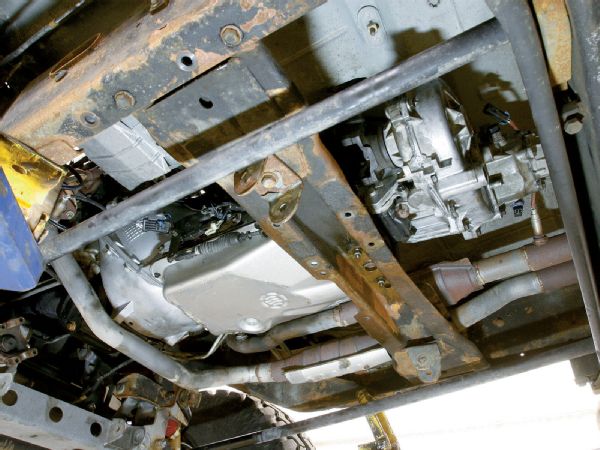
Water Leaking Into Jeep Auto Trans?
Q My mechanic says that my Jeep has water in the automatic transmission. I can’t quite understand how water could get in there. Is there any way for me to test this myself?
Jimmy Lee Mathues
Via fourwheeler.com

A You didn’t say what model Jeep you had, but all transmissions have vents to allow heat-caused pressure buildup to vent. If you have driven through deep water when the transmission was on the hot side, then as the trans cooled, it possibly could have sucked in some water if the water level was above the vent line.
However, my guess is that it is coming from the transmission cooler. The cooler is embedded within the tank of the radiator. As transmission fluid flows through it, the surrounding water cools the fluid before it is sent back to the transmission. If one had a leak in the transmission cooler, it’s possible for the exchange of fluid both ways—that is, ATF could get into the radiator as well as coolant getting into the transmission.
ATF in the radiator can usually be seen as small red droplets floating on top of the coolant. Coolant (water) in the ATF is harder to distinguish. The easiest way is to pull the dipstick and push the fluid off of it with your finger into a clean, dry pan. Heat the pan on your stove, and any water will start to sizzle when it reaches 212 degrees Fahrenheit; ATF should go to somewhere around 300 degrees before it starts to smoke and burn off.
Brake-Bleeding Old Bronco IIs and Rangers
Q I have a Bronco II on which I just did a clutch replacement, including a new hydraulic slave cylinder. I tried to bleed the system using the bleeder screw, but still have a clutch that will not release properly and a pedal that feels spongy. Can you offer me a clue as to proper bleed procedures?
Jim Casey
New York, NY
A You’re actually in luck because my research showed a tech bulletin by the Schaeffler Group, which makes LUK clutches that deal with 1984-98 Ford Aerostar, Bronco II, Explorer, and Ranger, as well as Mazda B2300, B3000, B4000, and Navajo. It seems there are times when it is difficult to get all the air out of the master cylinder due to the angle that it is mounted at on the firewall.
As you know, the pedal assembly pushes directly on the master cylinder, and the reservoir is mounted separately, higher up on the firewall. Take a look at the master cylinder and you will see that it is mounted at an angle that allows air to be trapped at the very end. The Schaeffler tech bulletin suggests removing the master cylinder and holding it almost parallel with the ground, or slightly tilted so the rear portion is lower. Then take a long prybar through the bottom of bellhousing, and pry the cylinder rearward several times. The reversed fluid movement will force any trapped air out of the master cylinder and up into the reservoir. Be sure to keep the bleeder screw closed when doing this. This is probably designed to be done when the vehicle is on a lift. I think that it might be easier not to remove the master cylinder and just lift the front of the vehicle with ramps or jackstands high enough to get the master cylinder in the right position, and then crawl under the vehicle with your prybar.
7.3L Power Stroke Transmission/T-Case Options
Q I really enjoy reading your magazine and was wondering if you would give me your opinion on my project. I’m building a family mudbogger/trail rider that is street-legal. What I have is a ’97 F-350 four-door with 52-inch Michelin tires and Rockwell axles with disc brakes. The part I need help with is deciding which motor, transmission, and transfer case to use. These are my choices: a Detroit 6V53, ’97 Cummins 5.9L, ’94-’97 Power Stroke 7.3L (engines), Spicer 3053a, E40D (transmissions), Rockwell T136, NP 200, and NP 205 (T-cases), which I’ve salvaged from my ’07 TTC truck. I need to use these due to my budget, and I already have them sitting here. Any help will be greatly appreciated.
Wesley Wells
Saint Augustine, FL
A That’s a lot of choices to be made. I think a lot is going to depend on how much adaptation you want to do between the engine, trans and transfer case. All of the engines you mention have merits. The 6V53 at first sounds interesting, and for those not familiar with it, here is a bit of information: First, it has been around for more years than I have. It displaces 318 cubic inches, with each cylinder displacing 53. It has a Roots-type blower, and some versions even had an additional turbocharger. It is quite heavy, weighing in at about 1,800 pounds. They were available in rotation of both directions, so make sure if you pick one that it turns in the right direction. Revs are limited to around 2,200, if I remember right. I would pass on it as an engine swap candidate for this application.
Mud requires lots of wheel speed and engine rpm, so I think that I would go with the Power Stroke over the Cummins. However, a lot would depend on which engine in your collection was in better condition.
Transmission choice would be whichever is the easiest and least expensive to adapt to the engine. For mud and general driving, the E4OD automatic would be the choice if you can deal with the electronics needed to make it work. It would need a completely updated rebuild and (perhaps) two huge transmission fluid coolers. However, it may just not be up to the task.
The Spicer 3053a generally came out of 5-ton military trucks and is quite stout, having five speeds with top gear being an overdrive. It’s not the fastest-shifting gearbox, but plenty strong for your application. There were some 6.9L Fords that were actually built with the Clark five-speed, and I’m sure the SAE bellhousings have the same transmission bolt pattern, so you’re going to have to locate one of these bellhousings to use the Spicer trans.
The T136 would not be my choice of transfer case due to its overall size. You would have to make your own adapter to the NP205, unless it is like the 200 and designed as a divorced-mount unit.
Have you considered just selling all your extra parts and using the money to buy a ZF5 five-speed manual, or even the six-speed version along with a matching transfer case, and bolting them directly to the Ford diesel?
For a trail machine, that Crew Cab is pretty darn long. If you don’t have a real need for a long six- or eight-foot box, consider shortening up the wheelbase and using, say, a 3-foot flatbed.
You have a major project ahead, so I really advise collecting all the parts ahead of time and completely thinking through all of the needed steps before actually starting on the conversion.
Where To Write
Address your correspondence to: Four Wheeler, 831 S. Douglas St., El Segundo, CA 90245. All letters become the property of Four Wheeler, and we reserve the right to edit them for length, accuracy, and clarity. The editorial department can also be reached through the website at www.fourwheeler.com. Due to the volume of mail, electronic and otherwise, we cannot respond to every reader, but we do read everything.